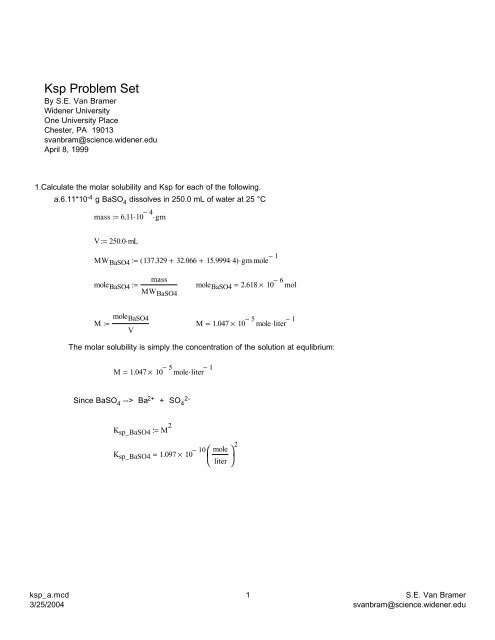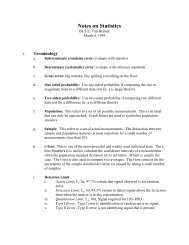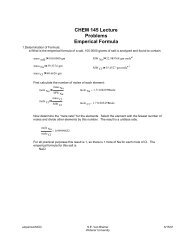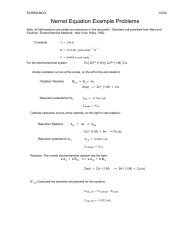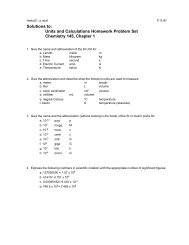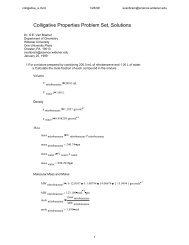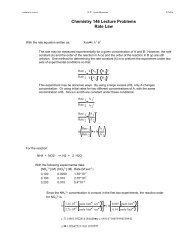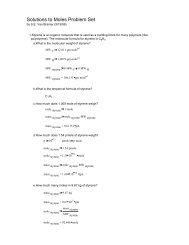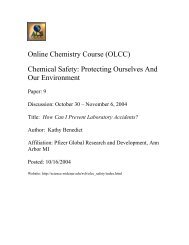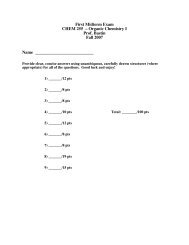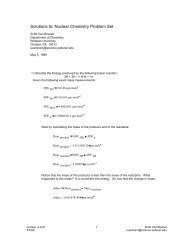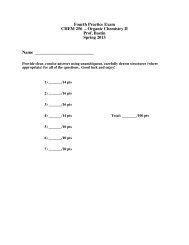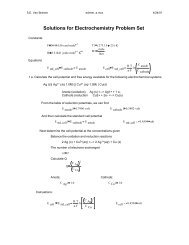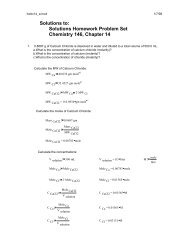Ksp Problem Set - Widener University
Ksp Problem Set - Widener University
Ksp Problem Set - Widener University
Create successful ePaper yourself
Turn your PDF publications into a flip-book with our unique Google optimized e-Paper software.
<strong>Ksp</strong> <strong>Problem</strong> <strong>Set</strong><br />
By S.E. Van Bramer<br />
<strong>Widener</strong> <strong>University</strong><br />
One <strong>University</strong> Place<br />
Chester, PA 19013<br />
svanbram@science.widener.edu<br />
April 8, 1999<br />
1.Calculate the molar solubility and <strong>Ksp</strong> for each of the following.<br />
a.6.11*10 -4 g BaSO 4 dissolves in 250.0 mL of water at 25 °C<br />
mass := 6.11⋅10 − 4 ⋅gm<br />
V :=<br />
250.0⋅mL<br />
MW BaSO4 := ( 137.329 + 32.066 + 15.9994⋅4) ⋅gm⋅<br />
mole − 1<br />
mass<br />
mole BaSO4 := mole BaSO4 = 2.618 × 10 − 6 mol<br />
MW BaSO4<br />
M<br />
mole BaSO4<br />
:= M 1.047 10 − 5 − 1<br />
= × mole⋅liter<br />
V<br />
The molar solubility is simply the concentration of the solution at equlibrium:<br />
M 1.047 × 10 − 5 − 1<br />
=<br />
mole⋅liter<br />
Since BaSO 4 --> Ba 2+ + SO 4<br />
2-<br />
K sp_BaSO4 := M 2<br />
K sp_BaSO4 = 1.097 × 10 − 10<br />
⎛<br />
⎜<br />
⎝<br />
mole<br />
liter<br />
⎞<br />
⎟<br />
⎠<br />
2<br />
ksp_a.mcd<br />
3/25/2004<br />
1 S.E. Van Bramer<br />
svanbram@science.widener.edu
.0.3295 g BaF 2 dissolves in 250.0 mL of water at 25 °C<br />
mass :=<br />
0.3295⋅gm<br />
V :=<br />
250.0⋅mL<br />
MW BaF2 := ( 137.329 + 18.998⋅2) ⋅gm⋅<br />
mole − 1<br />
mass<br />
mole BaF2 := mole BaF2 = 1.879 × 10 − 3 mol<br />
MW BaF2<br />
M<br />
mole BaF2<br />
:= M 7.517 10 − 3 − 1<br />
= × mole⋅liter<br />
V<br />
The molar solubility is simply the concentration of the solution at equlibrium:<br />
M 7.517 × 10 − 3 − 1<br />
=<br />
mole⋅liter<br />
Since BaF 2 --> Ba 2+ + 2 F -<br />
K sp_BaF2 := 4⋅M 3<br />
K sp_BaF2 = 1.699 × 10 − 6<br />
⎛<br />
⎜<br />
⎝<br />
mole<br />
liter<br />
⎞<br />
⎟<br />
⎠<br />
3<br />
ksp_a.mcd<br />
3/25/2004<br />
2 S.E. Van Bramer<br />
svanbram@science.widener.edu
c.4.807*10-4 g AgCl dissolves in 250.0 mL of water at 25 °C<br />
mass := 4.807⋅10 − 4 ⋅gm<br />
V :=<br />
250.0⋅mL<br />
MW AgCl := ( 107.8682 + 35.4527) ⋅gm⋅<br />
mole − 1<br />
mass<br />
mole AgCl := mole AgCl = 3.354 × 10 − 6 mol<br />
MW AgCl<br />
M<br />
mole AgCl<br />
:= M 1.342 10 − 5 − 1<br />
= × mole⋅liter<br />
V<br />
The molar solubility is simply the concentration of the solution at equlibrium:<br />
M 1.342 × 10 − 5 − 1<br />
=<br />
mole⋅liter<br />
Since AgCl --> Ag+ + Cl-<br />
K sp_AgCl := M 2<br />
K sp_AgCl = 1.8 × 10 − 10<br />
⎛<br />
⎜<br />
⎝<br />
mole<br />
liter<br />
⎞<br />
⎟<br />
⎠<br />
2<br />
ksp_a.mcd<br />
3/25/2004<br />
3 S.E. Van Bramer<br />
svanbram@science.widener.edu
d.1.667 g CaF 2 dissolves in 100.0 L of water at 25 °C<br />
mass :=<br />
1.667⋅gm<br />
V :=<br />
100⋅L<br />
MW CaF2 := ( 40.078 + 2⋅18.998) ⋅gm⋅<br />
mole − 1<br />
mole CaF2 :=<br />
mass<br />
MW CaF2<br />
mole CaF2 = 0.021 mol<br />
M :=<br />
mole CaF2<br />
V<br />
M 2.135 × 10 − 4 − 1<br />
=<br />
mole⋅liter<br />
The molar solubility is simply the concentration of the solution at equlibrium:<br />
M 2.135 × 10 − 4 − 1<br />
=<br />
mole⋅liter<br />
Since CaF 2 --> Ca 2+ + 2 F -<br />
M<br />
2M<br />
K sp =<br />
M⋅( 2⋅M) 2<br />
K sp_CaF2 := 4M 3<br />
K sp_CaF2 = 3.894 × 10 − 11<br />
⎛<br />
⎜<br />
⎝<br />
mole<br />
liter<br />
⎞<br />
⎟<br />
⎠<br />
3<br />
ksp_a.mcd<br />
3/25/2004<br />
4 S.E. Van Bramer<br />
svanbram@science.widener.edu
2.Use the K sp values calculated above to determine the mass of each that will dissolve in 2.0 L of<br />
deionized water.<br />
a.BaSO 4<br />
K sp_BaSO4 = X 2<br />
X :=<br />
K sp_BaSO4<br />
X 1.047 × 10 − 5 − 1<br />
=<br />
mole⋅liter<br />
mole_disolved := X⋅2⋅liter<br />
mole_disolved = 2.094 × 10 − 5 mol<br />
mass_disolved :=<br />
mole_disolved⋅MW BaSO4<br />
mass_disolved = 4.888 × 10 − 3 gm<br />
b.BaF 2<br />
K sp_BaF2 = 4⋅<br />
X 3<br />
X :=<br />
⎛<br />
⎜<br />
⎝<br />
K sp_BaF2<br />
4<br />
⎛<br />
⎜<br />
⎝<br />
⎞<br />
⎟<br />
⎠<br />
1<br />
3<br />
⎞<br />
⎟<br />
⎠<br />
X 7.517 × 10 − 3 − 1<br />
=<br />
mole⋅liter<br />
mole_disolved := X⋅2⋅liter<br />
mole_disolved = 0.015 mol<br />
mass_disolved :=<br />
mole_disolved⋅MW BaF2<br />
mass_disolved = 2.636 gm<br />
ksp_a.mcd<br />
3/25/2004<br />
5 S.E. Van Bramer<br />
svanbram@science.widener.edu
c.AgCl<br />
K sp_AgCl = X 2<br />
X :=<br />
K sp_AgCl<br />
X 1.342 × 10 − 5 − 1<br />
=<br />
mole⋅liter<br />
mole_disolved := X⋅2⋅liter<br />
mole_disolved = 2.683 × 10 − 5 mol<br />
mass_disolved :=<br />
mole_disolved⋅MW AgCl<br />
mass_disolved = 3.846 × 10 − 3 gm<br />
d.CaF 2<br />
K sp_CaF2 = 4⋅<br />
X 3<br />
X :=<br />
⎛<br />
⎜<br />
⎝<br />
K sp_CaF2<br />
4<br />
⎛<br />
⎜<br />
⎝<br />
⎞<br />
⎟<br />
⎠<br />
X 2.135 × 10 − 4 − 1<br />
=<br />
mole⋅liter<br />
1<br />
3<br />
⎞<br />
⎟<br />
⎠<br />
mole_disolved := X⋅2⋅liter<br />
mole_disolved = 4.27 × 10 − 4 mol<br />
mass_disolved :=<br />
mole_disolved⋅MW CaF2<br />
mass_disolved = 0.033 gm<br />
ksp_a.mcd<br />
3/25/2004<br />
6 S.E. Van Bramer<br />
svanbram@science.widener.edu
3.Use the K sp values calculated above to determine.<br />
a.The mass of BaSO 4 that will dissolve in 500 mL of 0.10 M sodium sulfate.<br />
Sodium sulfate is a salt, it dissociates completely according to<br />
Na2SO4 --> 2Na1+ + SO42-<br />
− 1<br />
C Na2SO4 := 0.1⋅mole⋅liter<br />
C SO4_initial := C Na2SO4<br />
Next the equlibrium for the solubility of BaSO 4<br />
BaSO4 Ba2+ + SO42-<br />
⋅( )<br />
K sp_BaSO4 = X C SO4_initial + X<br />
If you assume that X is small this rearanges to:<br />
K sp_BaSO4 =<br />
X⋅C SO4_initial<br />
X :=<br />
K sp_BaSO4<br />
C SO4_initial<br />
X 1.097 × 10 − 9 − 1<br />
=<br />
mole⋅liter<br />
Which shows that the assumption was reasonable<br />
From this we can calculate the mass of BaSO 4 that dissolves<br />
V :=<br />
500⋅mL<br />
mole BaSO4 :=<br />
V⋅<br />
X<br />
mole BaSO4 = 5.483 × 10 − 10 mol<br />
mass BaSO4 :=<br />
mole BaSO4 ⋅MW BaSO4<br />
mass BaSO4 = 1.28 × 10 − 7 gm<br />
ksp_a.mcd<br />
3/25/2004<br />
7 S.E. Van Bramer<br />
svanbram@science.widener.edu
.The mass of BaF 2 that will dissolve in 250 mL of 0.10 M potassium fluoride.<br />
Potassium fluoride is a salt, it dissociates completely according to<br />
KF --> K1+ + F1-<br />
− 1<br />
C KF := 0.1⋅mole⋅liter<br />
C F_initial := C KF<br />
Next the equlibrium for the solubility of BaF 2<br />
BaF2 Ba2+ + 2 F1-<br />
⋅( ) 2<br />
K sp_BaF2 = X C F_initial + 2X<br />
If you assume that X is small this rearanges to:<br />
2<br />
K sp_BaF2 = X⋅C F_initial<br />
X :=<br />
K sp_BaF2<br />
C F_initial<br />
2<br />
X 1.699 × 10 − 4 − 1<br />
=<br />
mole⋅liter<br />
Which shows that the assumption was reasonable<br />
From this we can calculate the mass of BaF 2 that dissolves<br />
V :=<br />
250⋅mL<br />
mole BaF2 :=<br />
V⋅<br />
X<br />
mole BaF2 = 4.248 × 10 − 5 mol<br />
mass BaF2 :=<br />
mole BaF2 ⋅MW BaF2<br />
mass BaF2 = 7.448 × 10 − 3 gm<br />
ksp_a.mcd<br />
3/25/2004<br />
8 S.E. Van Bramer<br />
svanbram@science.widener.edu
c.The mass of AgCl that will dissolve in 5.0 L of 10 -4 M lithium chloride.<br />
Lithium is a salt, it dissociates completely according to<br />
LiCl --> Li1+ + Cl1-<br />
C LiCl 10 − 4 − 1<br />
:= ⋅mole⋅liter<br />
C Cl_initial := C LiCl<br />
Next the equlibrium for the solubility of AgCl<br />
AgCl Ag1+ + Cl1-<br />
⋅( )<br />
K sp_AgCl = X C Cl_initial + X<br />
If you assume that X is small this rearanges to:<br />
K sp_AgCl =<br />
X⋅C Cl_initial<br />
X :=<br />
K sp_AgCl<br />
C Cl_initial<br />
X 1.8 × 10 − 6 − 1<br />
= mole⋅liter<br />
Which shows that the assumption was reasonable<br />
From this we can calculate the mass of BaSO 4 that dissolves<br />
V :=<br />
5⋅L<br />
mole AgCl :=<br />
V⋅<br />
X<br />
mole AgCl = 9 × 10 − 6 mol<br />
mass AgCl :=<br />
mole AgCl ⋅MW AgCl<br />
mass AgCl = 1.29 × 10 − 3 gm<br />
ksp_a.mcd<br />
3/25/2004<br />
9 S.E. Van Bramer<br />
svanbram@science.widener.edu
d.The mass of CaF 2 that will dissolve in 5000.0 L of 0.10 M potassium fluoride.<br />
Potassium fluoride is a salt, it dissociates completely according to<br />
KF --> K1+ + F1-<br />
− 1<br />
C KF := 0.1⋅mole⋅liter<br />
C F_initial := C KF<br />
Next the equlibrium for the solubility of CaF 2<br />
CaF2 Ca2+ + 2 F1-<br />
⋅( ) 2<br />
K sp_CaF2 = X C F_initial + 2X<br />
If you assume that X is small this rearanges to:<br />
2<br />
K sp_CaF2 = X⋅C F_initial<br />
X :=<br />
K sp_CaF2<br />
C F_initial<br />
2<br />
X 3.894 × 10 − 9 − 1<br />
=<br />
mole⋅liter<br />
Which shows that the assumption was reasonable<br />
From this we can calculate the mass of CaF 2 that dissolves<br />
V :=<br />
5000⋅L<br />
mole CaF2 :=<br />
V⋅<br />
X<br />
mole CaF2 = 1.947 × 10 − 5 mol<br />
mass CaF2 :=<br />
mole CaF2 ⋅MW CaF2<br />
mass CaF2 = 1.52 × 10 − 3 gm<br />
ksp_a.mcd<br />
3/25/2004<br />
10 S.E. Van Bramer<br />
svanbram@science.widener.edu
4.Use the K sp values calculated in the previious problem set to determine the mass of precipitate<br />
formed and the concentration all ions remaining in soultion when:<br />
a.50.0 mL of 0.10 M barium acetate is mixed with 100.0 mL of 0.10 M sodium sulfate.<br />
Sodium sulfate is a salt, it dissociates completely according to<br />
Na 2 SO 4 --> 2Na 1+ + SO 4<br />
2-<br />
− 1<br />
C Na2SO4 := 0.1⋅mole⋅liter<br />
50⋅mL<br />
C SO4_initial := C Na2SO4 ⋅<br />
100⋅mL<br />
− 1<br />
C SO4_initial = 0.05 mole⋅liter<br />
Barium Acetate is a salt, it dissociates completely according to<br />
Ba(CH3COO)2 --> Ba2+ + 2 CH3COO-<br />
− 1<br />
C BaCH3COO := 0.1⋅mole⋅liter<br />
50⋅mL<br />
C Ba_initial := C BaCH3COO ⋅<br />
100⋅mL<br />
− 1<br />
C Ba_initial = 0.05 mole⋅liter<br />
Since Barium Sulfate is insoluble, it will for a precipitate. In this direction the reaction has a<br />
large value for K, so we'll assume it goes to completion. Since the moles of barium and<br />
sulfate are equal there is no limiting reagent.<br />
V := 100⋅mL<br />
mole BaSO4 :=<br />
mass BaSO4 :=<br />
C Ba_initial ⋅V<br />
mole BaSO4 ⋅MW BaSO4<br />
mole BaSO4 = 5 × 10 − 3 mol<br />
mass BaSO4 = 1.167 gm<br />
Next the equlibrium for the solubility of BaSO 4<br />
BaSO4 Ba2+ + SO42-<br />
K sp_BaSO4 = X 2<br />
( )<br />
1<br />
2<br />
X := K sp_BaSO4<br />
X 1.047 10 − 5 − 1<br />
= × mole⋅liter<br />
From this we can give the concentration of all the ions in solution:<br />
C Ba := X<br />
C SO4 := X<br />
50⋅mL<br />
C CH3COO := C BaCH3COO ⋅<br />
100⋅mL<br />
50⋅mL<br />
C Na := C Na2SO4 ⋅<br />
100⋅mL<br />
C Ba 1.047 10 − 5 − 1<br />
= × molliter<br />
C SO4 1.047 10 − 5 − 1<br />
= × molliter<br />
− 1<br />
C CH3COO = 0.05 molliter<br />
− 1<br />
C Na = 0.05 molliter<br />
ksp_a.mcd<br />
3/25/2004<br />
11 S.E. Van Bramer<br />
svanbram@science.widener.edu
.100.0 mL of 0.15 M barium chlorate is mixed with 250.0 mL of 0.10 M potassium fluoride.<br />
potassium fluorie is a salt, it dissociates completely according to<br />
KF --> K1+ + F1-<br />
− 1<br />
C KF := 0.1⋅mole⋅liter<br />
250⋅mL<br />
− 1<br />
C F_initial := C KF ⋅<br />
C F_initial = 0.071 mole⋅liter<br />
350⋅mL<br />
Barium Chlorate is a salt, it dissociates completely according to<br />
Ba(ClO 3 ) 2 --> Ba 2+ + 2 ClO 3<br />
1-<br />
− 1<br />
C BaClO3 := 0.15⋅mole⋅liter<br />
100⋅mL<br />
− 1<br />
C Ba_initial := C BaClO3 ⋅<br />
C Ba_initial = 0.043 mole⋅liter<br />
350⋅mL<br />
Since Barium Fluoride is insoluble, it will form a precipitate. In this direction the reaction has<br />
a large value for K, so we'll assume it goes to completion. Since the concentration of the<br />
barium is smaller, it is the limiting reagent.<br />
V := 350⋅mL<br />
mole BaF2 := C Ba_initial ⋅V<br />
mole BaF2 = 0.015 mol<br />
mass BaF2 :=<br />
mole BaF2 ⋅MW BaF2<br />
mass BaF2 = 2.63 gm<br />
Next the equlibrium for the solubility of BaF 2<br />
BaF 2 Ba 2+ + 2 F 1-<br />
C F := C F_initial − C Ba_initial<br />
⋅( ) 2<br />
K sp_BaF2 = X C F + 2⋅<br />
X<br />
Assuming X is small, this simplifies to:<br />
K sp_BaF2 =<br />
X⋅( C F ) 2<br />
X<br />
K sp_BaF2<br />
:=<br />
2<br />
C F<br />
X 2.082 × 10 − 3 − 1<br />
=<br />
mole⋅liter<br />
From this we can give the concentration of all the ions in solution:<br />
C Ba := X<br />
C Ba 2.082 × 10 − 3 − 1<br />
=<br />
molliter<br />
− 1<br />
C F = 0.029 molliter<br />
100⋅mL<br />
− 1<br />
C ClO3 := 2C BaClO3 ⋅<br />
C ClO3 = 0.086 molliter<br />
350⋅mL<br />
250⋅mL<br />
C K := C KF ⋅<br />
350⋅mL<br />
− 1<br />
C K = 0.071 molliter<br />
ksp_a.mcd<br />
3/25/2004<br />
12 S.E. Van Bramer<br />
svanbram@science.widener.edu
c.75.0 mL of 0.015 M silver nitrate is mixed with 1.0 L of 10 -4 M lithium chloride.<br />
Lithium Chloride is a salt, it dissociates completely according to<br />
LiCl --> Li 1+ + Cl 1-<br />
C LiCl 10 − 4 − 1<br />
:= ⋅mole⋅liter<br />
1000⋅mL<br />
C Cl_initial := C LiCl ⋅<br />
1075⋅mL<br />
C Cl_initial 9.302 × 10 − 5 − 1<br />
=<br />
mole⋅liter<br />
Silver Nitrate is a salt, it dissociates completely according to<br />
AgNO3 --> Ag+ + NO31-<br />
− 1<br />
C AgNO3 := 0.015⋅mole⋅liter<br />
75⋅mL<br />
C Ag_initial := C AgNO3<br />
1075⋅mL<br />
C Ag_initial 1.047 × 10 − 3 − 1<br />
=<br />
mole⋅liter<br />
Since silver chloride is insoluble, it will form a precipitate. In this direction the reaction has a<br />
large value for K, so we'll assume it goes to completion. However, the concentrations are<br />
pretty small here. We better check Q to see if a precipitate will form:<br />
Q :=<br />
Q = 9.735 × 10 − 8<br />
K sp_AgCl = 1.8 × 10 − 10<br />
Since Q is greater than K, a precipitate will form and chloride will be the limiting reagent.<br />
V :=<br />
C Ag_initial ⋅C Cl_initial<br />
1075⋅mL<br />
⎛<br />
⎜<br />
⎝<br />
mole<br />
liter<br />
⎞<br />
⎟<br />
⎠<br />
⎛<br />
⎜<br />
⎝<br />
2<br />
mole<br />
liter<br />
⎞<br />
⎟<br />
⎠<br />
2<br />
mole AgCl :=<br />
C Cl_initial ⋅V<br />
mole AgCl = 1 × 10 − 4 mol<br />
mass AgCl :=<br />
mole AgCl ⋅MW AgCl<br />
mass AgCl = 0.014 gm<br />
Next the equlibrium for the solubility of AgCl<br />
AgCl Ag1+ + Cl1-<br />
C Cl := C Cl_initial − C Ag_initial<br />
⋅( )<br />
K sp_AgCl = X C Cl + X<br />
ksp_a.mcd<br />
3/25/2004<br />
13 S.E. Van Bramer<br />
svanbram@science.widener.edu
Assuming X is small this simplifies to:<br />
K sp_AgCl =<br />
X :=<br />
( K sp_AgCl )<br />
C Cl<br />
X⋅C Cl<br />
X −1.888<br />
× 10 − 7 − 1<br />
=<br />
mole⋅liter<br />
C Cl −9.535<br />
× 10 − 4 − 1<br />
=<br />
molliter<br />
So the assumption was fine and now we can go on.<br />
From this we can give the concentration of all the ions in solution:<br />
C Ag := X<br />
C Ag −1.888<br />
× 10 − 7 − 1<br />
=<br />
molliter<br />
C Cl −9.535<br />
× 10 − 4 − 1<br />
=<br />
molliter<br />
75⋅mL<br />
C NO3 := C AgNO3 ⋅<br />
1075⋅mL<br />
1000⋅mL<br />
C Li := C LiCl ⋅<br />
1075⋅mL<br />
C NO3 1.047 10 − 3 − 1<br />
= × molliter<br />
C Li 9.302 × 10 − 5 − 1<br />
=<br />
molliter<br />
d.100 L of 0.50 M calcium chloride is mixed with 5000.0 L of 0.10 M potassium fluoride.<br />
Potassium Fluoride is a salt, it dissociates completely according to<br />
KF --> K1+ + F1-<br />
− 1<br />
C KF := 0.1⋅mole⋅liter<br />
5000⋅liter<br />
C F_initial := C KF ⋅<br />
5100⋅liter<br />
− 1<br />
C F_initial = 0.098 mole⋅liter<br />
Calcium Chloride is a salt, it dissociates completely according to<br />
CaCl2 --> Ca2+ + 2 Cl1-<br />
− 1<br />
C CaCl2 := 0.015⋅mole⋅liter<br />
C Ca_initial :=<br />
100⋅liter<br />
C CaCl2<br />
5100⋅liter<br />
C Ca_initial 2.941 × 10 − 4 − 1<br />
=<br />
mole⋅liter<br />
ksp_a.mcd<br />
3/25/2004<br />
14 S.E. Van Bramer<br />
svanbram@science.widener.edu
Since Calcium Fluoride is insoluble, it will form a precipitate. In this direction the reaction<br />
has a large value for K, so we'll assume it goes to completion. However, the concentrations<br />
are pretty small here. We better check Q to see if a precipitate will form:<br />
Q :=<br />
V :=<br />
C Ca_initial ⋅( C F_initial ) 2<br />
Q = 2.827 × 10 − 6<br />
5100⋅liter<br />
⎛<br />
⎜<br />
⎝<br />
mole<br />
liter<br />
⎞<br />
⎟<br />
⎠<br />
K sp_CaF2 = 3.894 × 10 − 11<br />
3<br />
⎛<br />
⎜<br />
⎝<br />
mole<br />
liter<br />
⎞<br />
⎟<br />
⎠<br />
3<br />
Since Q is greater than K, a precipitate will form and calcium will be the limiting reagent.<br />
mole CaF2 :=<br />
C Ca_initial ⋅V<br />
mole CaF2 = 1.5 mol<br />
mass CaF2 :=<br />
mole CaF2 ⋅MW CaF2<br />
mass CaF2 = 117.111 gm<br />
Next the equlibrium for the solubility of CaF2<br />
CaF2 Ca2+ + 2 F1-<br />
C F := C F_initial − C Ca_initial<br />
⋅( ) 2<br />
K sp_CaF2 = X C F + 2⋅<br />
X<br />
Assuming X is small this simplifies to:<br />
2<br />
K sp_CaF2 = X⋅C F<br />
X :=<br />
( K sp_CaF2 )<br />
C F<br />
2<br />
X 4.075 × 10 − 9 − 1<br />
=<br />
mole⋅liter<br />
− 1<br />
C F = 0.098 molliter<br />
So the assumption was fine and now we can go on.<br />
From this we can give the concentration of all the ions in solution:<br />
C Ca := X<br />
C Cl :=<br />
100⋅liter<br />
C CaCl2<br />
5100⋅liter<br />
5000⋅liter<br />
C K := C KF ⋅<br />
5100⋅liter<br />
C Ca 4.075 10 − 9 − 1<br />
= × molliter<br />
− 1<br />
C F = 0.098 molliter<br />
C Cl 2.941 × 10 − 4 − 1<br />
=<br />
molliter<br />
− 1<br />
C K = 0.098 molliter<br />
ksp_a.mcd<br />
3/25/2004<br />
15 S.E. Van Bramer<br />
svanbram@science.widener.edu


